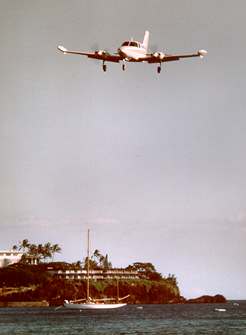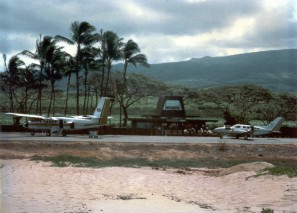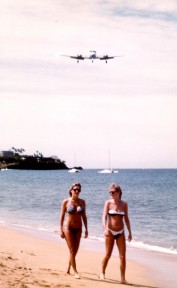
Feature Story- Commuter Landings at Kaanapali Airstrip
by Peter N. Forman
 Pilots
seldom forget interesting landing approaches. Mainland airline pilots
can describe in detail the River Visual at Washington National, or Expressway
Visual into La Guardia. In Hawaii, commuter pilots have fewer approaches
to fly, so remembrances of challenging fields fly perpetual holding patterns
in their memories. Twin-Beech pilots recall timing approaches into Molokai's
Kalaupapa Airfield so as to avoid crashing surf at the end of the runway,
and OK Air and Princeville Airways pilots will remember recruiting cowboys
by radio to clear cattle from Princeville's only runway.
Pilots
seldom forget interesting landing approaches. Mainland airline pilots
can describe in detail the River Visual at Washington National, or Expressway
Visual into La Guardia. In Hawaii, commuter pilots have fewer approaches
to fly, so remembrances of challenging fields fly perpetual holding patterns
in their memories. Twin-Beech pilots recall timing approaches into Molokai's
Kalaupapa Airfield so as to avoid crashing surf at the end of the runway,
and OK Air and Princeville Airways pilots will remember recruiting cowboys
by radio to clear cattle from Princeville's only runway.
Ask a former Royal Hawaiian pilot what his favorite airport was, and
chances are he'll say Kaanapali. For one thing, the field was short for
a Cessna 402- about 2700 feet. Short runways tend to decrease our enthusiasm
when we anticipate a flight, but looked at in the rearview mirror of time
such fields take on a whole new flavor.
Secondly, there was the positioning of the field. Its asphalt runway
began just beyond Kaanapali Beach and cut a narrow swath through high
green cane fields. No fence of substance separated runway from beach and
there were times on short final when every pilot pulled her up just a
tad for fear of giving some unsuspecting beachcomber a crewcut.
 Then
there was the terminal, a small affair with friendly employees and a tiny
lounge on the second floor known as the windsock. Metal-detectors and
x-ray machines never found their way to Kaanapali, and luggage typically
flew to the same destination as the passenger. Modern air travelers would
hardly recognize this outpost as an airport. Any Royal pilot worth his
salt carried a bathing suit, and if a few hours separate landing from
takeoff, a mere 141 steps would transport a pilot from line shack/changing
room to the Pacific.
Then
there was the terminal, a small affair with friendly employees and a tiny
lounge on the second floor known as the windsock. Metal-detectors and
x-ray machines never found their way to Kaanapali, and luggage typically
flew to the same destination as the passenger. Modern air travelers would
hardly recognize this outpost as an airport. Any Royal pilot worth his
salt carried a bathing suit, and if a few hours separate landing from
takeoff, a mere 141 steps would transport a pilot from line shack/changing
room to the Pacific.
I began my career in Hawaii as flight instructor in single-engine Cessnas. While transiting Kaanapali on cross-country flights, how I longed to set down on that runway and take a quick dip or stroll to nearby resorts for lunch. Alas, Kaanapali was off limits to all planes except Royal's. Nothing short of a well-timed engine failure would allow me to lawfully set down on such a strip.
A couple years later I made my way to the left seat of one commuter, then eventually several others. When I heard Royal had hired a pilot with qualifications similar to mine, I haunted that airline until they hired me. Under the watchful eye of pilots Art Phillips and Leo Flaherty, I received my Kaanapali baptism. The C-402 should be slowed to 95 knots on final (110 mph on the B models), retard throttles over the beginning of the runway, set her down without floating, go around if things didn't look right, and oh yes, watch the wind line.
The wind line stood out as the most remarkable obstacle to a Kaanapali landing. Beyond the cane fields rose the West Maui Mountains, which shielded much of the southwestern side of the island from trade winds. Kaanapali Airport lay near the edge of this wind shadow, and, depending on wind direction that hour, windsocks could hang limp or dance along in 25 knot winds. Sometimes the ocean sock showed no wind and the mountain sock stuck straight out. You could even see the wind line drawn across the sea of sugar cane and blue ocean surface. When the line crossed the far end of the field, it presented no serious problems to landings. A wind line in the touchdown zone was a different animal entirely.
I remember one such day. Until this moment I held the dubious distinction of having never rejected a visual approach landing in commercial service. A couple feet above the ground as we crossed the wind line- Whoosh! the plane is now ten feet up and climbing, my right hand has already advanced the throttles, and we are going around. Ok, I am ready this time. Wind line still about the same location on base and final, but I'm ready. We settle in for landing- Whoosh! climbing again and going around. Jack Sullivan operated Kaanapali Unicom that day, and he advised it was time for me to head to Kahului Airport. In baseball you get three strikes, but in Kaanapali landings if you missed twice you're trying too hard, and it's off to Kahului you go.
Most arrivals into Kaanapali took place with trade winds throughout approach and touchdown, which reduced groundspeed and made for delightful, though certainly not boring approaches. At times bathing beauties provided potential distractions to Royal pilots, but a mantra such as "Keep your eyes on the runway" helped one get through such trying times.
Often several Royals would line up for approach. In such cases a lead pilot made a right turn off the end of the runway onto a short taxiway which looped back to the runway, and there he waited at the edge of the cane fields for the last 402 to land. The whole group then backtaxied along the runway to terminal ramp.
Around 1983 Royal acquired two Twin Otters, which flew nearly exclusively on the Honolulu to Kaanapali route. They carried more passengers than 402s but were vulnerable to gusty winds, and on particularly nasty days only the twin Cessnas landed at this beach strip.
In 1986 Royal announced that Kaanapali Airport would close to make room for a hotel project. Many loyal passengers wished this were not so, but if Kaanapali service were coming to an end, then they should be on the last plane out of town. For this reason Royal needed four extra 402s for the final Kaanapali to Honolulu flight that late afternoon. One could only imagine the crowds in the windsock lounge, the hugs, the leis passed that day.
Without Kaanapali, Royal Hawaiian Air Service's route system could not produce a profit, and in short time the airline ceased operations.
Today, should you stroll along the beach northwest of the Maui Sheraton, you will still not see any luxury hotel on the site of Kaanapali Airport. If you have snorkeling gear you might take a dip offshore, because the reef and colorful fish are magnificent. Walk a little higher, a little farther from the water, and you might notice a peculiar weather phenomenon: It is calm wind where you stand, but fifty feet further along the beach the seas are turbulent and winds animate the wild sugar cane stalks. Cinch up your seatbelt, my friend, it's one of those days.
Do you have a story about a flight or aviation experience in Hawaii you would like to share? Send a copy to flyhi@wecanfly.com and if we like it we'll publish your work right here.
